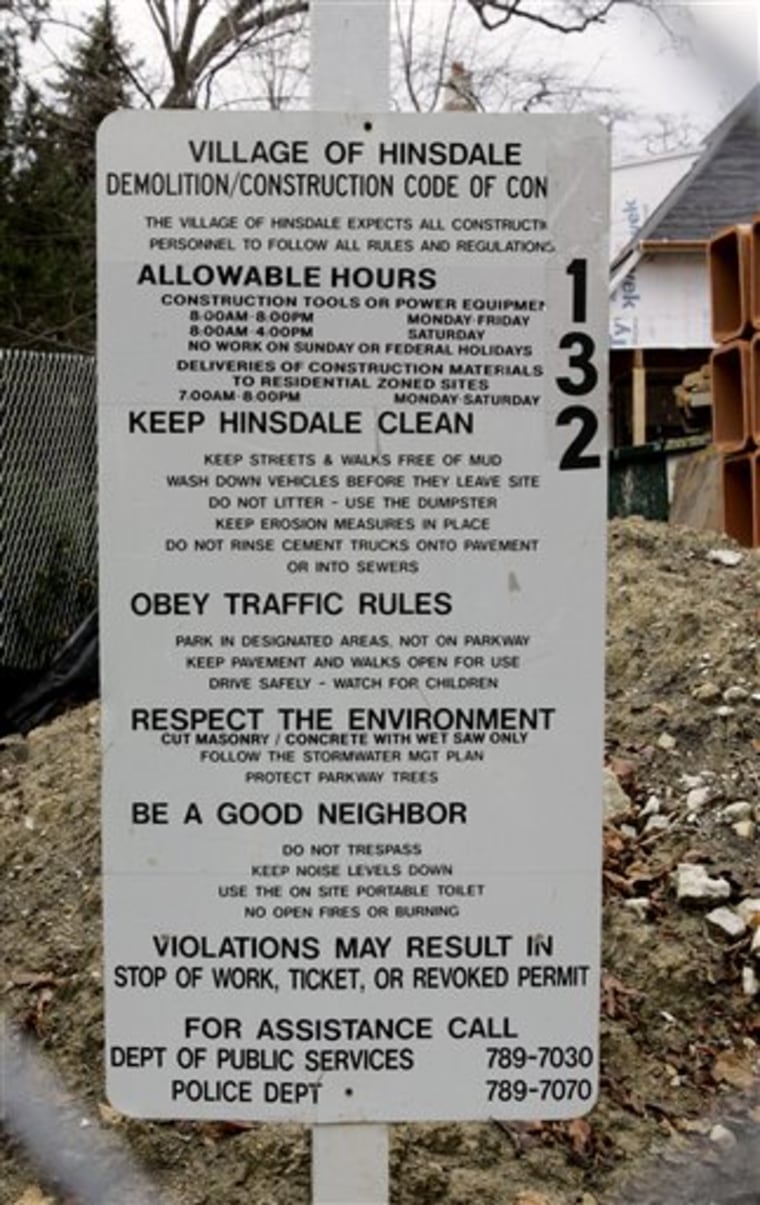It was a rare occurrence in a community with a national reputation for tearing down old houses: A developer bought the historic cottage at 327 S. Oak St. but didn't bulldoze it into oblivion.
The norm in this leafy Chicago suburb and affluent communities around the country has been to allow builders to demolish older homes to make way for far larger, far flashier houses — dubbed “McMansions” by critics.
But a teardown tide that surged for a decade has begun to turn, largely due to a housing-market slump, but also thanks to the growing influence of preservationists.
As a five-year real estate boom fizzled this year, teardowns plummeted by at least 20 percent nationally, roughly corresponding to the drop in housing starts, said Stephen Melman of the National Association of Home Builders.
At the same time, though, preservationists across the country have exerted increasing influence in a quest to protect historic neighborhoods.
“The whole issue of preservation is more on the radar of all communities,” said Genell Scheurell, a Chicago representative for the Washington-based National Trust for Historic Preservation. “It absolutely wasn't the case 10 years ago.”
The Oak Street house is a case in point.
The small, curvy, red-bricked cottage was designed in the 1920s by architect R. Harold Zook, sometimes called the Frank Lloyd Wright of Hinsdale. So when a developer said he intended to demolish the house, preservationists scrambled to save it.
“A lot of people said the Zook house was the line in the sand,” said Bob Saigh, who took the lead in saving the home. “It was a galvanizing situation.”
Preservationists arranged to have the 82-year-old house lifted intact and rolled 1½ miles to parkland donated by the village. Workers are putting the finishing touches on a three-story, six-bedroom mansion listed at $5.5 million on the lot where the two-bedroom Zook house stood.
“The builder admired the house, but it was in his way,” Saigh said. “It was move it or lose it.”
Hinsdale, a 133-year-old village some 20 miles west of Chicago, gained notoriety years ago in preservationist circles.
“It's been the poster child for teardowns,” said Royce Yeater, who heads the Midwest office of the National Trust for Historic Preservation.
About 30 percent of Hinsdale's 4,700 homes replaced those that were razed, giving the village the dubious distinction of having one of the highest teardown rates in the United States.
“Other places are nervous with 10 percent teardowns,” said village Trustee Jean Follett, a committed preservationist. “We say, ‘Ha! That's nothing!’ ”
National teardown figures are not compiled and difficult to assess, but the National Association of Home Builders has estimated that 75,000 houses are razed and replaced with larger homes annually.
The National Trust says Chicago's suburbs, California's Bay Area, Palm Springs and neighborhoods around Washington, D.C.,are among the hardest-hit areas.
“Teardowns spread through a community like a cancer,” Richard Moe, president of the National Trust for Historic Preservation said in an address in San Francisco last summer. “I believe they represent the biggest threat to America's older neighborhoods since the heyday of urban renewal and interstate highway construction. ... The pace of teardowns has amounted to an orgy of irrational destruction.”
Moe said old neighborhoods needed to be preserved so “that generations to come can live in them, learn from them, be sheltered and inspired by them.”
To that end, preservation groups are issuing warnings as suburbs sprawl toward older communities.
The Chicago suburb of Kenilworth, for example, was named this year as one of the nation's 11 most endangered places by the National Trust for Historic Preservation. Thirty-three of the village's 850 homes have been razed since 2001.
When a developer took steps to demolish a home designed by the firm of Daniel H. Burnham — a top American architect 100 years ago — placards protesting its destruction appeared in yards throughout the upscale community.
Just before its scheduled demolition last year, a good-Samaritan neighbor stepped in to buy the home for more than $2 million in order to save it.
That controversy and the National Trust listing helped spur Kenilworth officials to action.
On Monday, the village board approved a zoning change that provides incentives for owners and developers to fix up old homes rather than tear them down.
“They've had their head in the sand a lot in Kenilworth,” said David Bahlman, head of the Landmarks Preservation Council of Illinois. “But the good thing is the issue is out there now. Officials know they need to do something.”
Follett said there's also newfound agreement among Hinsdale trustees.
“It's unanimously for preservation, which is a change,” she said.
Following the national trend, Hinsdale is expected to issue fewer than 80 teardown permits in 2006 — well below last year's record of 118.
Moving the Zook house last year might have helped galvanize the preservationist cause. But no one is suggesting that project serves as a model for saving other homes.
That, Follett said, will come with other initiatives, including granting landmark status to more buildings to make them off limits to developers. So far, just 19 have the designation.
Some municipalities have established historic districts in which teardowns are banned outright. Hinsdale would like to do something similar, Follett said.
Still, few believe teardowns are a thing of the past, however delighted preservationists are about the current downward trend.
The potential profits of teardowns simply are too attractive to dissuade developers for long, said Daniel McMillen, who heads the Center for Urban Real Estate at the University of Illinois at Chicago.
“I think some people might argue that the teardown market was a bubble and now that bubble has burst,” McMillen said. “But I don't think that is the case. I think the teardown market will bounce back.”
